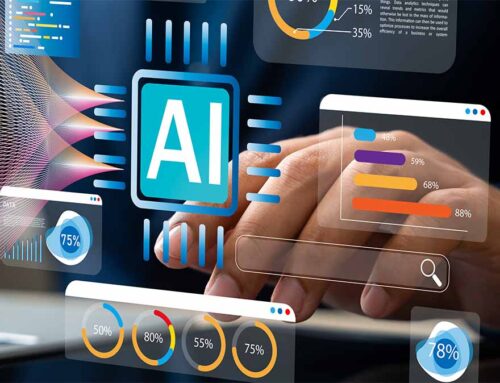Imagine this: You’ve made it to the front of the line at the coffee shop, and with a laptop in one hand and drink in the other, you head over to the only seat available. As you settle your things and log in, you notice seated across the table is “Neurobot,” a sleek, silver-haired AI with an affinity for algorithms. It churns out content faster than a caffeinated squirrel on a keyboard. Your marketing agency, once the reigning content czar, now faces a formidable challenge.
Neurobot’s digital ink flows effortlessly, creating blog posts, social media updates, and catchy slogans—all in the blink of a digital eye. Revenue slips away like sand through your fingers. How do you stand out when Neurobot’s content is as ubiquitous as cat memes? How do you differentiate yourself when your competitor’s AI whizzes through proposals faster than you can say “machine learning”?
Several of my friends who run marketing agencies have a big challenge: their customers are using Artificial Intelligence (AI) to create content that they were creating less than a year ago. Revenue is lost. How do you differentiate yourself from AI as a competitor? How do you differentiate yourself if your albeit human competitor company uses AI to create what you’re creating far more efficiently – perhaps to build proposals or customer deliverables faster than you can without AI? What if you are a pathologist and AI starts reducing the time to evaluate images?
Part 1: What is AI Software vs all the other software we have used in the past?
AI mimics human intelligence’s ability to learn from experience and adjust to new inputs. How is AI software different from the accounting, spreadsheet, and graphic design software we have all used in the past? Well, those applications likely already use AI today, a type called classical machine learning. What is newer is Deep Learning AI. This is the AI that takes us from automation to decision-making, from tool to potential collaborator or competitor.
But what is AI exactly? At TechHouse, we often say that you can’t use pronouns like “it” or “them” when trying to solve a problem because they can hide the problem you’re trying to solve. Similarly, we need to get good, clear terms if we’re going to be able to navigate a world where AI can both be a great partner and a significant competitor.
AI is a broad term referring to many different specialized technologies. Like in medicine, the AI industry has different specializations to solve different problems. Although a podiatrist is a medical doctor, I would not ask them to cure my migraines. (Though, at this point, I may try that, too!) Similarly, only engaging the proper AI can help us reach our goals.
Over the past 50-plus years, software has automated work. With a defined set of instructions, business software applications calculate numbers, generate reports, and store information for later access. We became accustomed to automated billing, payroll, and sales funnels. In the 1970s and 1980s, software programming combined with powerful machines to automate assembly lines and contributed to the rust belt. Job loss is a genuine concern, and creating new jobs is a real opportunity.
Before AI existed, software did what humans told it to do and did it faster than a human. The instructions may have been complex, but they were instructions. We told the computer what to do, and it did it. We tested the software to ensure that the instructions provided were not flawed so that we could, in turn, ensure the behavior of the software. We could trust the software to perform functions, such as calculating math problems, determining a financial statement, and even in medical devices to monitor heartbeats, blood pressure, and more. Trust in these systems was due to rigorous testing of clearly defined instructions.
AI software is different. AI does not carry out tasks with predefined rules. Instead, AI has a model, and humans train that model to make decisions. There are many different models, each suited for different types of decisions. The better suited the model is to the decision, and the more limited in scope and preciseness the testing, the more accurate and less probabilistic the answers may be.
What is an example of a trained model? Optical Character Recognition (OCR) software. For example, OCR software for accountants can scan invoices, identify the invoice number, date, and amount, and then enter that information into the accounting software invoice record. How does it accomplish this? Someone has trained it on what those invoices look like and where to find the invoice number, date, and amount.
Unlike traditional software, which works from a defined set of rules, AI software infers the answer from prior learning. It makes its best guess as to the right answer rather than following instructions to create an answer.
To get the best guess, AI models data. AI models work from tremendously large datasets, such as the foundational models built on 40 years of digitized information from the Internet.
In our next post, we will explore how this affects our understanding of AI and how we plan our business’s response.
Don’t Go It Alone: Some ways TechHouse can help
- Free Webinars to stay aware: Contact us for our upcoming webinars.
- Check out Kathy’s AI panel on Bright Talk June 21st, 2024, at 1pm eastern.
- Our CoPilot AwareTM Solution contains curated assessments, sample policies, communications, and guides for your AI Adoption journey.
- Training and mentoring for you and your team: from Cybersecurity to Critical thinking workshops, our team is dedicated to transferring skills to help your team thrive in this new world.
- Technical Preparedness and Tools: Engage us for an AI preparation, Data Governance, cybersecurity, or CoPilot/AI rollout in your organization.





